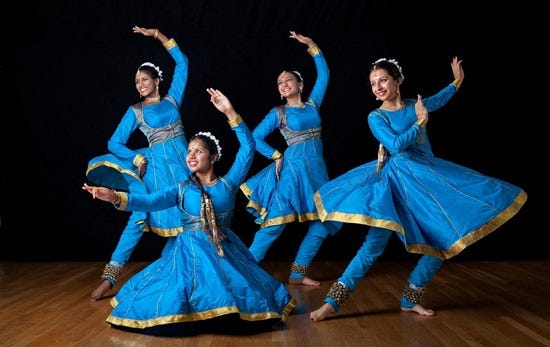Featured
- Get link
- X
- Other Apps
Dance is the hidden language of the soul
Dance is a movement of body in a rhythmic way usually to music within
a given space for the purpose of expressing an idea or emotion,
releasing energy or simply taking delight in the movement itself.
Dance is a powerful impulse, but the art of dance is that impulse
channelled by skilful performers into something that becomes intensely
expressive and that may delight spectators who feel no wish to dance
themselves. These two concepts of the art of dance—dance as a
powerful impulse and dance as a skilfully choreographed art practiced
largely by a professional few—are the two most important connecting
ideas running through any consideration of the subject. In dance, the
connection between the two concepts is stronger than in some other
arts, and neither can exist without the other.
Different Forms of Dances are:
1. Bharatnatyam
Performed on the celestial tunes of the Carnatic music, Bharatnatyam comes
from the state of Tamil Nadu in South. The dance form is known for its beautiful
body movements and gestures which are called Mudras in the traditional
language. It focuses on the hand gestures, leg movement and the facial
expressions of the dancer. India kept the dance form alive in the houses, and
today it is recognised as one of the most respectable art forms in India especially
in the Southern region of the country where it is a moment of pride for the women
of the house to learn the classical dance form of Bharatnatyam.
2. Kathak
Coming from the northern part of the country from the state of Uttar Pradesh,
Kathak comes from the word 'Katha' which means "story" in Hindi. Kathak is
often referred to as the dance of love, and it can be performed by both by the
male and female dancer together. This dance form focuses highly on the ankle
movements complemented by the ankle that has to match the beats of the music.
Ankle bells or gunghroos as they are called in the traditional language is an
important part of the discipline of this dance form.
3. Odissi
Odissi dance form comes from the state of Odisha in the eastern part of India.
The traditional dance has been derived from the Hindu temples in Odisha. Most
of the gestures and movements (Mudras) are inspired by the sculptors and idols
belonging to the ancient temples of India. The dance is performed as a way to
express the mythological tales of Hindu gods, including that of Shiva and Surya.
Odissi is considered as the oldest dance forms of India which are surviving till
today. Odissi dance is performed mostly by the women dancers, and it includes
more than 50 intriguing mudras (body movements).
4)JAZZ
Jazz dance, any dance to jazz accompaniments, composed of a profusion of forms.
Jazz dance paralleled the birth and spread of jazz itself from roots in Black
American society and was popularized in ballrooms by the big bands of
the swing era (1930s and ’40s). Jazz dance may allude to vernacular jazz or
to Broadway or dramatic jazz. The two types expand on African-American vernacular
styles of dance that arose with jazz music. Vernacular jazz dance
incorporates ragtime moves, Charleston, Lindy hop and mambo.
5)Hip Hop
Hip-hop dance began during the late 1960’s and early 1970’s, originally inspired by
the movements of African dancing, and flourished as a new style of dance performed
on the street for the people. Hip-hop dance is a unique and exciting style of street
dance that is most commonly performed to hip-hop music. Hip-hop dance is a vibrant
form of dance that combines a variety of freestyle movements to create a cultural
piece of art. Through its three main styles of popping, locking, and breaking, hip-hop
dance has evolved into one of the most popular and influential styles of dance.
6)Contemporary
Contemporary dance is a style of expressive dance that combines elements of
several dance genres including modern, jazz, lyrical and classical ballet.
Contemporary dancers strive to connect the mind and the body through fluid dance
movements. Contemporary dance stresses versatility and improvisation.
Contemporary dancers focus on floorwork, using gravity to pull them down to the
floor. This dance genre is often done in bare feet. Contemporary dance can be
performed to many different styles of music.
By Sukanya Solase
- Get link
- X
- Other Apps
Comments
Popular Posts
Why do Artists of Landscape Paintings Prefer Watercolor
- Get link
- X
- Other Apps






Excellent collection
ReplyDeleteThis post explains so many genre of dance form.... Amazing post
ReplyDeleteGood info about all dance forms
ReplyDelete